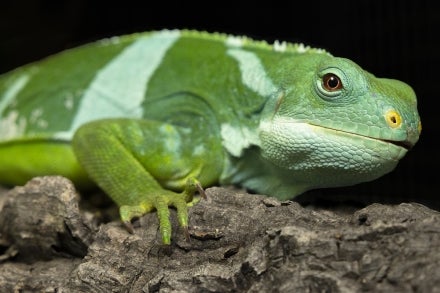
It’s remote, and it’s wet. Very, very wet. Even by field work standards, tracking tree-dwelling red ruffed lemurs in the far-flung deciduous tropical rain forests of northeastern Madagascar requires no small amount of courage, cooperation, fortitude, funding, organization, patience, intelligence, and a smattering of luck. But for primate expert Tim Eppley, Ph.D., postdoctoral associate, San Diego Zoo Global (SDZG), the work is urgent and necessary. “Red ruffed lemurs inhabit only a tiny pocket of their large island,” he said. “In the past 60 years, fragmentation has increased dramatically, with less than 10 percent of the forest remaining.” [caption id="attachment_135707" align="aligncenter" width="1600"] MUST “SEA” HABITAT
MUST “SEA” HABITAT
The Masoala peninsula, protruding from the Madagascar’s northeast corner, is a two-hour boat journey from Maroantsetra. As the land’s last intact rainforest, Masoala National Park is a stronghold for diverse and unique habitats and wildlife. (Photos by: Tim Eppley)[/caption] While this species may be fairly common in zoos, its status in the wild is dire—it is listed as Critically Endangered—mainly due to illegal logging and hunting. “There are about 113 lemur species endemic to Madagascar, and 95 percent of them are threatened with extinction, making lemurs the most threatened mammalian taxon in the world,” he added. But researchers from around the world are creatively collaborating to elucidate the mysteries surrounding these lemurs. Understanding the effects of fragmented landscapes on lemur behavior and feeding ecology will help direct effective forest protections, benefitting both wildlife and the Malagasy people. 
Lemur Lifestyle
In October 2017, several red ruffed lemur projects began in earnest. “We want to maximize our data collection over our funded four-year time frame,” said Tim. Red ruffed lemurs Varecia rubra consume mostly fruits, seeds, nectar, and pollen, adding leaves in a pinch; they are one of the few frugivores in Madagascar. They also have a fission-fusion social arrangement, so large groups gather at fruiting trees and disperse into smaller groups when food is scarce. [caption id="attachment_135709" align="aligncenter" width="800"] AGILE AND ARBOREAL
AGILE AND ARBOREAL
Red ruffed lemurs are striking in appearance and rarely have reason to come to the ground.[/caption] Females are receptive to breeding two to three days per year, between June and July. Following a gestation period of approximately four months, females give birth to up to three offspring (one or two infants is common; it is highly unusual among primates to have a litter!), which stay in a roughly made nest while adults search for food. Cyclones and other catastrophic events can impact reproductive success. “Cyclones throw off seasonal plants they need for food,” said Tim. “We are collecting fruits and other items they eat and examining them for nutritional values.” Over 600 plant samples are being analyzed. 
Studying the Tree Dwellers
SDZG partnered with Madagascar Biodiversity Partnership (MBP) to catch, measure, collar, and release adult red ruffed lemurs. In 2018, the experts at MBP helped collar six male and five female lemurs. Each VHF radio collar gathers behavior data (whether the animal is active or inactive), as well as skin temperature (used as a proxy for basal metabolic rate), both of which can vary seasonally. The collars “ping” when the receiver is within range, enabling researchers listening through headphones to reliably find them. [caption id="attachment_135711" align="aligncenter" width="800"] WADING FOR WILDLIFE
WADING FOR WILDLIFE
McAntonin is conducting a lemur survey in Masoala, scanning the forest for the elusive prosimians. Fortunately, red ruffed lemurs are very vocal, which can help researchers find them. (Photo by Tim Eppley)[/caption] But how on earth do you get a collar on a branch-scampering lemur high in the forest canopy? It’s not easy. A team hikes into the forest in search of a group of lemurs. A sedative is darted into the thigh of an adult animal and in 5 to 10 minutes, it tumbles into the waiting net. The lemur is secured in a breathable cloth tote and taken to the field station, where its heart rate, pulse, and body temperature are carefully monitored. “Animal safety is the team’s top priority,” said Tim. [caption id="attachment_135712" align="aligncenter" width="800"] CHIN UP!
CHIN UP!
Volatiana, a researcher, is patiently scouring the remote rainforest canopy with binoculars for red ruffed lemurs in Masoala National Park. It can take several hours to find them in the forest. (Photo by Tim Eppley)[/caption] Once the lemur is measured, weighed, and given a health check, a 50-gram (about 2 ounces) collar is secured with a neoprene band. Within 90 minutes, the lemur is completely recovered from the anesthesia, and researchers return the animal to the point of collection and monitor it until it rejoins its core group. “The lemurs sometimes fiddle with the collar during the first few hours, but they soon forget all about it,” noted Tim. The collars provide data every 15 minutes, providing researchers an important glimpse into red ruffed lemur life. 
Gut Check
For a look at the inner workings of the lemurs, some intrepid researchers are collecting fecal samples, which can be challenging when your subjects eat fruit all day. But despite the splat factor, “We’ve done remarkably well, collecting 112 fecal samples across 12 sites,” said Tim. The scat reveals the animals’ DNA, which can help determine how closely related red ruffed lemurs are to their neighbors, the black-and-white ruffed lemurs. These arboreal prosimians are separated by the Antainambalana River, but there is a potential hybrid zone. [caption id="attachment_135714" align="aligncenter" width="800"] SCANNING FOR SCAT
SCANNING FOR SCAT
Committed Malagasy people are crucial to conservation projects, like this researcher collecting red ruffed lemur scat samples for scientific analysis. (Photo by Tim Eppley)[/caption] DNA findings will illuminate whether reintroductions or translocation efforts are effective conservation measures in habitats where the population has low genetic diversity. Fecal samples also allow for gut microbiomes to be analyzed, which is important to understanding digestive health of the red ruffed lemur population. One Duke University study showed that fruit-eating lemurs harbored similar gut microbes across the island, while leaf-eating sifakas (a different type of lemur) had more ecosystem-specific gut microbes necessary to convert tough leaves into nutrients. Despite the logistical challenges and the constant war on mold at study sites, the work must go on! Long flights, treacherous boat crossings, and muddy hikes are par for the course, and none of it would be possible without the talented and committed students from the University of Antananarivo. “We have excellent local field assistants and graduate students working on this project,” said Tim. “We need more researchers working with the Malagasy people to preserve this species.” Conserving the red ruffed lemurs of Madagascar has never been more urgent. 
The Fab Four: Red Ruffed Lemurs at the Zoo
Leaping gracefully from tree to tree, golden eyes wide and watchful, the fluffy, flame-red lemurs are striking creatures to see in action. San Diego Zoo guests can observe—and hear—a raucous group of four red ruffed lemurs (sharing their habitat with a pair of blue-eyed black lemurs) in the Madagascar Forest area in Conrad Prebys Africa Rocks. This lemur species is unusual on several fronts, explained wildlife care specialist Yeleny Smith. “They are one of the few genera of lemurs that can have more than two offspring at a time, they are the most frugivorous, and they are the loudest,” she said. Red ruffed lemurs are not shy about communicating perceived danger and territory boundaries, and those calls can be heard over half a mile away. Red ruffed lemurs Morticia and Arche are the parents of two male offspring born in May 2019. The youngsters have Malagasy names: Mahitsy, meaning “crooked,” was named for the shape of his tail, while his robust brother was named Mahery, meaning “strong one.” Newborn red ruffed lemurs are tiny, helpless, and kitten-like. Yeleny said that Mahitsy was much weaker than his brother, and Morticia needed help caring for him, so staff intervened by providing nutritional support until he could feed on his own. 
Successful Partnership
As part of San Diego Zoo’s wildlife care protocol, lemur care specialists work with the primates using positive reinforcement to elicit behaviors that allow them to closely monitor the health and well-being of the animals. The animals “station” at a specific spot or touch a “target,” enabling staff to shift them from one place to another. “They can orient themselves so we can observe a specific body part or do a reproductive check,” Yeleny said, which minimizes stress for everyone. As primates go, red ruffed lemurs are “not as intellectually complex” as other species, so training may take a bit longer, and enrichment items are simplified so they can figure it out. “We work with them to help them succeed,” Yeleny added. But what they lack in puzzle-solving skills, they make up for in acrobatic dexterity. “They can hang by their feet like bats to access flowers and pollen.” 
Primates of the Forest
As voracious fruit eaters, lemurs devour seeds and pass them with a mound of fertilizer, which keeps the forests they depend on thriving (if the trees don’t get cut down). Since the 1970s, the San Diego Zoo has been a leader in breeding this species, and many red ruffed lemurs in North America are progeny of these conservation breeding efforts. These animals give zoo visitors an opportunity to learn about this fascinating and endangered species. And our intrepid SDZG field researchers are continuing the studies that can help save lemurs in Madagascar from extinction.




